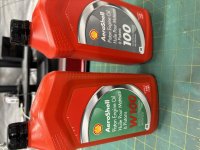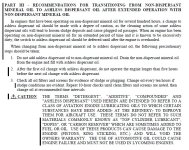AD OR Non-AD
respectfully, I don't see how in the world you could get the idea that a Lycoming service letter only applies to non-lycoming engines. The "all other" statement is in reference to turbos and the handful of specific engines models they call out in the previous paragraphs.
But thats the great thing about experimental aviation, you're free to proceed as you see fit.
D. All other engines must be operated on
non-dispersant mineral oil during the first 50 hours of operation, or until oil consumption has stabilized. Use of LW-16702, while required for certain engine models as listed in Part B above, could inhibit break-in on other engine models and therefore should not be used during break-in. Reference Service Bulletin No. 446, Service Bulletin No. 471, and/or Service Instruction No. 1409 for additional information. If an ashless dispersant oil is used in a new engine, or a newly overhauled engine, high oil consumption might possibly be experienced. The additives in some of these ashless dispersant oils may retard the break-in of the piston rings and cylinder walls. This condition can be avoided by the use of non- dispersant mineral oil until oil consumption has stabilized and then change to ashless dispersant oil. Non- dispersant mineral oil must also be used following the replacement of one or more cylinders until the oil consumption has stabilized.
Being an A&P you have more experience than me in this matter. The OP was asking about Aeroshell 100 and Aeroshell W100. One being a anti dispersant (W100) and the other one not (100). Paragraph D is pretty clear that a Non-AD should be used. Does not say ok to use an AD providing no other additives are involved just do not use an AD until oil consumption is stabilized or 50 hrs. Since Mike Busch and I'm guessing the majority of users or at least a decent % (Including me) used an AD type oil from the very beginning (W100) I was trying to make some since of this bulletin and why one would choose to disregard Paragraph D from the company that is warrantying the engine. My 390 did seem to take quite some time to what I would consider fully break-in (Oil usage slowly crept down to 1 qt every 10 hours) but that took close to 100 hrs. and later 1 qt every 12 hours after 200 hours.
The use of a Non-AD type oil and Lycoming gives guidance on going to an AD along with the process and risk (Sludge build-up) just seems an unnecessary part of an engine break-in BUT paragraph 5 is very specific on its guidance.
In the next year I'll have a 540 to break in. Hopefully Lycoming can clarify their intention of paragraph 5 by then.
Regardless I do appreciate the input.
Just saw a later post and it's possible that when Lycoming uses (In some of these) that if you ensure your AD of choice does not contain additional additives, they are ok to use. Just not worded very well in my engineering opinion.
(Proper grammar was never my strength)
Also just noticed when they updated the service instruction going from M to N (End of July 2020) they specially added the wording non-dispersant in front of mineral oil in the first sentence of paragraph D.
 change, I also have Aeroshell 100. Haven’t run the latter, but just added 6 qts. of it during this oil change. Okay to also use for break in? Is it okay to mix with the W100? Drain it and go back to W100? Mike Busch?
change, I also have Aeroshell 100. Haven’t run the latter, but just added 6 qts. of it during this oil change. Okay to also use for break in? Is it okay to mix with the W100? Drain it and go back to W100? Mike Busch? 






